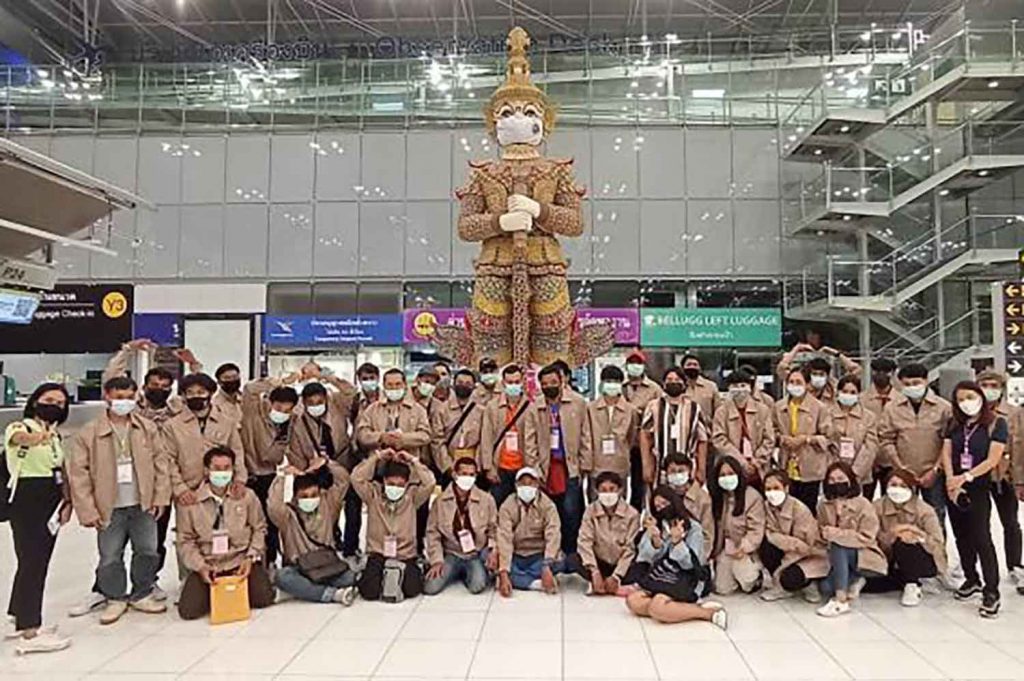၂၀၂၂ ခုနှစ် အစပိုင်း ထုတ်လုပ်ရေး အခြေအနေများ အနည်းငယ် ဆုတ်ယုတ်လာ
IHS Markitမှ ၂၀၂၂ ဖေဖော်ဝါရီလဆန်းတွင် ထုတ်ပြန်သော မြန်မာ ထုတ်လုပ်မှု PMI™ သတင်းထုတ်ပြန်ချက်တွင် ၂၀၂၂ ခုနှစ်၏ အစပိုင်းတွင် ထုတ်လုပ်ရေး အခြေအနေများ အနည်းငယ် ဆုတ်ယုတ်လာသည်ဟု သုံးသပ်တင်ပြထားပါသည်။
အဓိက တွေ့ရှိချက်များ
- ထုတ်လုပ်မှုနှင့် အော်ဒါအသစ်များ ဇန်နဝါရီလတွင် မသိမသာ မြန်သည့်နှုန်းဖြင့် ကျဆင်းသွားခြင်း
- လက်ကျန် အလုပ်များမှာ လျှပ်စစ်မီး ပြတ်တောက်မှုများ နှင့် ကုန်ကြမ်းရှားပါးမှုများ အကြားတွင် စံချိန်တင် မြင့်တက်လာခြင်း
- ငွေကြေးဖောင်းပွမှု ဖိအားပေးမှုများ ပြင်းထန်လာခြင်း
တွက်ချက်နည်း
IHS Markitမြန်မာ ထုတ်လုပ်မှု PMI™ ကို ထုတ်လုပ်သူ ၄၀၀ ခန့်ပါဝင်သည့် အဖွဲ့တစ်ခုမှ ထည့်ကုန် ဝယ်ယူရေး မန်နေဂျာများထံ ပို့ပေးခဲ့သည့် မေးခွန်းလွှာများ အတွက် ရရှိသည့် ဖြေကြားချက်များကို အခြေခံပြီး တွက်ချက်ပါသည်။ ဤအဖွဲ့တွင် GDP အား ထောက်ပံ့မှုကို အခြေခံပြီး အသေးစိတ်ကဏ္ဍနှင့်လုပ်သားအင်အား ပမာဏ အမျိုးမျိုး ပါဝင်အောင် ရွေးခဲ့သည်။
စစ်တမ်းအတွက် ဖြေကြားချက်များကို လစဉ် ဒုတိယ လဝက်ပိုင်းမှာ ကောက်ခံခြင်းဖြစ်ပြီး ယခင်လနှင့်နှိုင်းယှဉ်ပြီးပြောင်းလဲမှုကို ညွှန်ပြပါသည်။
စစ်တမ်း၏ ကိန်းရှင်တိုင်း အတွက် ပျံ့နှံ့မှု အညွှန်းကို တွက်ချက်ပါသည်။ အညွှန်းမှာ ‘ပိုမြင့်သည့်’ ဖြေကြားချက်များ၏ ရာခိုင်နှုန်းနှင့် ‘အပြောင်းအလဲမရှိ’ဟု ဖြေခဲ့ကြသူတို့၏ ရာခိုင်နှုန်း တစ်ဝက်ကို စုပေါင်းမှု ဖြစ်ပါသည်။
အညွှန်းများမှာ ၀ နှင့် ၁၀၀ အကြား ရှိနိုင်ပြီး ၅၀ အထက်တွင် ရှိနေပါက ခြုံပြောရလျှင် ယခင်လထက် တိုးတက်မှုကို ပြပြီး၊ ၅၀ အောက် ဆိုပါက ခြုံကြည့်လျှင် ကျဆင်းမှုကို ညွှန်ပြ ပါသည်။ ယင်းနောက်မှာ အညွှန်းများကို ရာသီအလိုက် ညှိပေးရပါသည်။
အဓိကအကျဆုံး ကိန်းဂဏန်းမှာ ထည့်ကုန်ဝယ်ယူရေးမန်နေဂျာများ၏ အညွှန်း Purchasing Managers’ Index™ (PMI) ဖြစ်ပါသည်။
PMI မှာ အောက်ပါ အညွှန်း ငါးခုတို့၏ ချိန်ဆတွက်ထားသည့် ပျမ်းမျှဂဏန်း ဖြစ်သည်-
- အော်ဒါသစ်များ (၃၀%)၊
- ထုတ်လုပ်မှု (၂၅%)၊
- အလုပ်နေရာ (၂၀%)၊
- ပစ္စည်းပေးသွင်းသူတို့၏ ပေးသွင်းမှု ကြာမြင့်ချိန်များ (၁၅%) နှင့်
- သိုလှောင်ထားသည့် ထည့်ကုန်များ (၁၀%)။
PMI ကို တွက်ချက်နိုင်ရန် ပစ္စည်းပေးသွင်းသူတို့၏ ပေးသွင်းမှု ကြာမြင့်ချိန်များ အညွှန်းကို အခြား အညွှန်း များနှင့် ယှဉ်ရနိုင်အောင် ဦးတည်ချက်ကို ပြောင်းပေးထားပါသည်။
ကောက်ယူထားသည့် စစ်တမ်း ဒေတာကို ထုတ်ပြန်မှု နောက်ပိုင်းတွင် ပြန်လည် ပြင်ဆင်ခြင်း မရှိသော်လည်း ရာသီအလိုက် ညှိပေးရမည့် အချက်များကိုမူ အချိန်အခါအလိုက် ညှိပေးနိုင်သောကြောင့် ရာသီအလိုက်ညှိထားသည့် စစ်တမ်း ဒေတာများအပေါ် သက်ရောက်မှု ရှိနိုင်ပါသည်။

ဒေတာကို ၂၀၂၂ ဇန်နဝါရီ ၁၂-၂၁ ရက်များတွင် စုစည်းခဲ့သည်။
၂၀၂၂ ခုနှစ် အဖွင့်လက မြန်မာနိုင်ငံ ထုတ်လုပ်ရေး ကဏ္ဍတွင်း လုပ်ကိုင်မှု အခြေအနေများ ပိုမြန်ဆန်စွာ ဆုတ်ယုတ်လာကြောင်းကို ဖေါ်ပြနေသည်။
နိုင်ငံရေး အခြေအနေက ထုတ်လုပ်မှုနှင့် အော်ဒါအသစ်များကို ထိခိုက်စေနေပြီး လျှပ်စစ်မီး ပြတ်တောက်မှုများ၊ ကုန်ကြမ်း ရှားပါးမှုများနှင့် ငွေသား ပြတ်တောက်မှုများကို ကုမ္ပဏီများ မလွှဲမရှောင်သာ ကြုံကြရသည်။
အကျိုးဆက်အဖြစ် လက်ကျန် အလုပ်များမှာ ဒေတာကို စုစည်းလာခဲ့သည့် ခြောက်နှစ်ကျော် ကာလအတွင်း အများဆုံး နှုန်းဖြင့် မြင့်တက်လာခဲ့ချိန်မှာ ပြင်းထန်သည့် ကြန့်ကြာမှုများ ရှိမြဲရှိနေခဲ့သည်။
ပိုပြီးအပြုသဘော ဆောင်သည့် အချက်အဖြစ် ဖေါ်ပြရလျှင် ကုမ္ပဏီများက အလုပ်သမား ဦးရေကို တစ်လချင်း ယှဉ်ကြည့်လျှင် တိုးခန့်ခဲ့ကြောင်း အစီရင်ခံခဲ့ကြပြီး အနာဂတ်ကို အကောင်းမြင်နေကြကြောင်း အတည်ပြုကြသည်။
ဈေးနှုန်းများနှင့် ပတ်သက်ပြီး ပြောရလျှင် အခြေအနေမသာသည့် ငွေလဲလှယ်နှုန်းများ၊ ကုန်ကြမ်းရှားပါးမှု နှင့် ပို့ဆောင်ခများ မြင့်တက်လာခြင်းက ကုန်ကျစရိတ်များကို မြှင့်တင်ရန် ဖိအားပေးမှုများဖြစ်လာကြသည်။
မိမိတို့၏ အမြတ်အစွန်းများကို ကာကွယ်သည့် အနေနှင့် ကုမ္ပဏီများက ရောင်းဈေးများကို အရှိန်ဖြင့် မြှင့်တင်ခဲ့ကြသည်။
အဓိကအကျဆုံး IHS Markit မြန်မာ ထုတ်လုပ်မှု PMI™ အညွှန်းကိန်း – ထုတ်လုပ်မှု လုပ်ကိုင်နိုင်စွမ်းကို ဖော်ပြပေးသည့် ပေါင်းစပ်ထားသည့် တစ်ခုတည်းသော ကိန်းဂဏန်းကို ဇန်နဝါရီတွင် ၄၈.၅ မှာ မှတ်တမ်းတင်ခဲ့ရာ ဒီဇင်ဘာ၏ ၄၉.၀ ထက် မသိမသာ နိမ့်ကျသွားခဲ့ပြီး ၁၇ လ ဆက်တိုက် အပြောင်းအလဲမရှိ အမှတ် ၅၀.၀ အောက်မှာ ရှိနေပါသည်။
သို့သော် ယခုနောက်ဆုံး ကျဆင်းမှုမှာ ဒသမဂဏန်းမျှသာရှိခဲ့ပြီး လက်ရှိ ကျဆင်းမှု အစဉ်ထဲတွင် ဒုတိယ အားအပျော့ဆုံး ဖြစ်သည်။
ဆုတ်ယုတ်မှုအတွက် အဓိကအကျဆုံးမှာ ထုတ်လုပ်မှု ပမာဏများ ထပ်မံကျဆင်းမှုဖြစ်သည်။
အချို့သော ကုမ္ပဏီများက ထုတ်လုပ်မှု တိုးလာခြင်းကို မှတ်တမ်းတင်ခဲ့ကြသော်လည်း အခြားသူတို့ကမူ နိုင်ငံရေး မတည်ငြိမ်မှုများ နှင့် ထည့်ကုန် ဝယ်ယူမှု အခက်အခဲများကို ထောက်ပြလျက် ထုတ်လုပ်မှု ကျလာကြောင်း ဆိုကြသည်။
အလာတူစွာပင် မြန်မာကုန်စည် ထုတ်လုပ်သူတို့ ရရှိခဲ့ကြသည့် အော်ဒါအသစ်များပါ ၁၇ လ ဆက်တိုက် ကျဆင်းလာခဲ့ပြီး သုံးလအတွင်းမှာ ကျဆင်းနှုန်း အများဆုံးဖြစ်သည်။
ဈေးဝယ်များ၏ ဘဏ္ဍာရေး ပြဿနာများနှင့် နိုင်ငံရေး မတည်ငြိမ်မှုများက ပြည်တွင်း ဈေးကွက်ရှိ ဝယ်လိုအားအပေါ် ဖိစီးနေကြသည်။
ထုတ်လုပ်မှုနှင့် အော်ဒါအသစ်များ ထပ်မံကျဆင်းလာနေသောကြောင့် ကုမ္ပဏီများက မိမိတို့၏ ဝယ်ယူမှုများကို ပြန်ထိန်းချုပ် လာကြရသည်။
ယခုအခါ ဝယ်ယူမှုများမှာ ၂၃ လ ဆက်တိုက် ကျဆင်းလာခဲ့ပြီး နောက်ဆုံး ကျဆင်းမှုမှာ ပြင်းထန်ခဲ့ကာ ဒီဇင်ဘာထက် အရှိန်ပိုရလာသည်။
ထုတ်လုပ်မှုအကြို လက်ကျန်စာရင်းများပါ ကျဆင်းသွားခဲ့ပြီး မှတ်တမ်းတစ်လျှောက်သမိုင်းထဲတွင် အပြင်းထန်ဆုံး ကျဆင်းမှုနှုန်း ဖြစ်ပါသည်။
ပို့ဆောင်ရေး အခြေအနေများ ခက်ခဲလာခဲ့ခြင်းက ရှိမြဲရှိနေသည့် ကုန်ကြမ်းရှားပါးမှုများနှင့် ပေါင်းမိခြင်းကြောင့် ပစ္စည်းပေးသွင်းသူတို့၏ ပစ္စည်းပေးသွင်းမှု ကြာမြင့်ချိန်များမှာထပ်ပြီး တိုးလာခဲ့ပြန်သည်။
စင်စစ်တွင် ပစ္စည်းပေးသွင်းသူတို့၏ စွမ်းဆောင်မှုမှာ ဒေတာ စုစည်းခဲ့သည့် ခြောက်နှစ်အတွင်း တတိယ အားအပျော့ဆုံးဖြစ်သည်။
- ပစ္စည်းပေးသွင်းမှု ကြန့်ကြာမှုများ၊
- ကုန်ကြမ်းပစ္စည်းရှားပါးမှုများနှင့်
- လျှပ်စစ်မီးပြတ်တောက်မှုများကို
ရင်ဆိုင်နေကြရသည့် မြန်မာနိုင်ငံတွင်း ထုတ်လုပ်ရေး ကုမ္ပဏီများသည် မပြီးဘဲ ကျန်ခဲ့သည့် အလုပ်များ စုပုံလာမှု စံချိန်အသစ် တင်လိုက်ကြသည်။
သို့ဖြစ်၍ ထုတ်လုပ်မှုအပြီး လက်ကျန်စာရင်းများပါ တဟုန်ထိုး ကျဆင်းသွားခဲ့သည်။
ဤအတောအတွင်း ဒီဇင်ဘာလတွင် ဆယ်လအတွင်း အနိမ့်ဆုံးမှာ ရှိနေခဲ့သည့် ထည့်ကုန်စရိတ်များ၏ ဖောင်းပွမှုနှုန်းမှာမူ နှစ်အစပိုင်းမှာ သိသာစွာ အရှိန်ရလာခဲ့သည်။
ကုန်ကြမ်း ဈေးများ၊ ပို့ဆောင်ခများ နှင့် စွမ်းအင် ဈေးနှုန်းများ မြင့်တက်လာမှုကို ရည်ညွှန်းခဲ့ကြသည့် အပြင် ဒေါ်လာ-ကျပ်ငွေ လဲလှယ်မှုနှုန်း ဆိုးရွားခြင်းကိုပါ ကြုံကြရသည်။
မြင့်တက်မှုနှုန်းမှာ ၃ လအတွင်း အမြင့်ဆုံး ဖြစ်လာပြီး မှတ်တမ်း၏ ရေရှည်ပျမ်းမျှနှုန်းကို ကျော်လွန်သွားသည်။
ကုမ္ပဏီအချို့က စရိတ်စက ဝန်ထုပ်ဝန်ပိုးများကို တစ်ဆင့် လွှဲပြီး ပခုံပြောင်း တင်ပေးရန် မိမိတို့၏ ရောင်းဈေးများကို ၁၄ လ ဆက်တိုက်အဖြစ် မြှင့်ပေးလိုက်ကြပါသည်။
ထို့အပြင် ငွေကြေးဖောင်းပွမှုနှုန်းသည် ပြီးခဲ့သည့်အောက်တိုဘာမှ စပြီး အနက်ရှိုင်းဆုံး ဖြစ်လာကာ စစ်တမ်း သမိုင်းတစ်လျှောက် အများဆုံး ဖြစ်လာသည်။
ထုတ်လုပ်မှု တိုးချဲ့ရေး စီမံကိန်းများကြောင့် ကုမ္ပဏီများက ဇန်နဝါရီလတွင် ၎င်းတို့၏ အလုပ်သမား ဦးရေကို တိုးမြှင့်ခဲ့ကြသည်။ အကောင်းမြင်မှုက သုံးလအတွင်း အနိမ့်ဆုံးမှာ ရှိနေခြင်းက မည်သို့ပင်ဖြစ်စေ၊ ကူးစက်မြန် ကပ်ရောဂါ၊ နိုင်ငံရေး မတည်ငြိမ်မှု နှင့်
ငွေကြေးဖောင်းပွမှု၏ ဖိအားပေးမှုများက ထုတ်လုပ်ရေး မျှော်လင့်ချက်များ အပေါ်တွင် ဆက်လက် ဖိစီးနေခြင်းကို ပြသနေသည်။

သုံးသပ်ချက်
နောက်ဆုံး စစ်တမ်း ရလဒ်များကို သုံးသပ်ဖေါ်ပြရာတွင်၊ IHS Markit မှ စီးပွားရေးပညာရှင် Shreeya Patel ပြောကြားသွားသည်မှာ-
"၂၀၂၂ ခုနှစ်၏ အဖွင့်လက မြန်မာနိုင်ငံ ထုတ်လုပ်ရေး ကဏ္ဍအတွင်းရှိ ရုန်းကန်ရမှုများ နှင့် PMI မှာ ဆယ့်ခုနစ်လဆက်တိုက် ကျဆင်းမှု နယ်ပယ်ထဲတွင် ရှိနေခြင်းကို ဆက်ညွှန်ပြလိုက်သည်။
နိုင်ငံရေး မတည်ငြိမ်မှုက ထုတ်လုပ်မှု နှင့် ပြည်တွင်းဝယ်လိုအားကို ထပ်မံပြီး ခြိမ်းခြောက်နေကာ လျှပ်စစ်မီး ပြတ်တောက်မှုများ နှင့် ကုန်ကြမ်းပစ္စည်း ရှားပါးမှုများကြောင့် လက်ကျန် အလုပ်များ စံချိန်တင် စုစည်းလာစေခဲ့သည်။
ထည့်ကုန်များ ရှားပါးနေခြင်း၊ ပို့ဆောင်ခနှုန်းများ မြင့်တက်လာခြင်း နှင့် ဒေါ်လာနှင့် ယှဉ်လျှင် ကျပ်ငွေနှုန်း ကျဆင်းလာနေခြင်းတို့ကြောင့် ဈေးနှုန်းများ၏ ဖိအားပေးမှုများမှာ မြင့်မားလျက် ကျန်ရှိနေပါသည်။
“ဒေတာများက စိုးရိမ်စရာ ကဏ္ဍများကို ဆက်လက်ဖေါ်ထုတ်ပြသနေသော်လည်း မျှော်လင့်ချက် လက္ခဏာများလည်း ရှိကြပါသည်။
ကုမ္ပဏီများက ထုတ်လုပ်မှုကို တိုးမြှင့်နိုင်မည်ဟု မျှော်လင့်ချက်ဖြင့် အလုပ်သမား ဦးရေကို တိုးချဲ့ခဲ့ကြပြီး ထုတ်လုပ်မှု နှင့် အော်ဒါအသစ်များထဲက ကျဆင်းမှုမှာ ခြုံပြောရလျှင် အနည်းငယ်မျှသာ ဖြစ်ခဲ့ပါသည်။
“ကုမ္ပဏီများက ၂၀၂၂ ခုနှစ်သည် မြန်မာနိုင်ငံအတွက် ထုတ်လုပ်ရေးအလားအလာကောင်းများကို ယူဆောင်လာမည်ဟု မျှော်လင့်လိုကြသော်လည်း လောလောဆယ်တွင် ငွေသားပြတ်တောက်မှုများ၊ ကုန်ကြမ်းမလုံလောက်မှု နှင့်
နိုင်ငံရေးမတည်ငြိမ်မှုက နောက်ကို ပြန်ဆွဲနေလျက် ရှိနေပါသည်”
တွက်ချက်နည်း
PMI စစ်တမ်းအား တွက်ချက်နည်းဆိုင်ရာ နောက်ထပ် အချက်အလက်များ အတွက် ကျေးဇူးပြုပြီး [email protected] သို့ ဆက်သွယ်ပါ။
PMI အကြောင်း
ထည့်ကုန်ဝယ်ယူရေးမန်နေဂျာများ၏ အညွှန်း (PMI™) စစ်တမ်းများကို ယခုအခါ နိုင်ငံပေါင်း ၄၀ ကျော်အပြင် ယူရိုဇုန်အတွင်းရှိ အထင်ကရ ဒေသများအတွက်ပါ ထုတ်ပြန်ပေးနေပါသည်။
၎င်းတို့မှာ ကမ္ဘာပေါ်တွင် အနီးကပ်ဆုံး စောင့်ကြည့်လေ့လာလျက်ရှိသည့် လုပ်ငန်းဆိုင်ရာ စစ်တမ်းများ ဖြစ်ကြပြီး ၎င်းတို့၏ စီးပွားရေးအတွက် ထူးခြားသည့် အလားအလာများဆိုင်ရာ လစဉ် အညွှန်းများကို နောက်ဆုံး အချက်အလက်များနှင့်အညီ တိကျစွာ ညွှန်ပြပေးနိုင်စွမ်းကြောင့် ဗဟိုဘဏ်များ၊ ဘဏ္ဍာရေး ဈေးကွက်များနှင့် လုပ်ငန်းဆိုင်ရာ ဆုံးဖြတ်ချက်များကို
ချမှတ်ပေးကြသူတို့ အားကိုးကြရပါသည်။
နောက်ထပ် လေ့လာလိုပါက ihsmarkit.com/products/pmi.html သို့ ဝင်ရောက်ကြည့်ရှုပါ။
IHS Markit အကြောင်း
IHS Markit (NYSE: INFO) သည် နိုင်ငံတကာ စီးပွားရေးများကို မောင်းနှင်ပေးကြသည့် အဓိက စက်မှုလုပ်ငန်းများနှင့် ဈေးကွက်များဆိုင်ရာ အရေးပါသည့် အချက်အလက်များ၊ ဆန်းစစ်ချက်များနှင့် ဖြေရှင်းနည်းများ အတွက် ကမ္ဘာ့ထိပ်သီး ကုမ္ပဏီ ဖြစ်ပါသည်။ မိမိတို့၏ ကုမ္ပဏီသည်မျိုးဆက်သစ် အချက်အလက်များ၊ ဆန်းစစ်ချက်များနှင့် ဖြေရှင်းနည်းများကို စီးပွားရေး လုပ်ငန်းများ၊ ဘဏ္ဍာရေးနှင့် အစိုးရများရှိ သုံးစွဲသူများထံသို့ ပို့ပေးပြီး ၎င်းတို့၏ လုပ်ကိုင်နိုင်စွမ်းကို မြှင့်တင်ပေးလျက် ပြည့်စုံ စိတ်ချရသည့် ဆုံးဖြတ်ချက်များ ချမှတ်စေနိုင်ရန် နက်ရှိုင်းသည့် အတွင်းသဘောများကို တင်ပြပေးပါသည်။ IHS Markit ထံတွင် စီးပွားရေး လုပ်ငန်းများနှင့် အစိုးရအဖွဲ့များမှ သုံးစွဲသူ ၅၀,၀၀၀ ကျော် ရှိရာ
Fortune Global 500 မှ ၈၀ ရာခိုင်နှုန်းနှင့် နိုင်ငံတကာ ထိပ်သီး ဘဏ္ဍာရေး အဖွဲ့အစည်းများ ပါဝင်ကြပါသည်။
IHS Markit မှာ IHS Markit Ltd. နှင့်/သို့မဟုတ် ၎င်းနှင့်ဆက်နွှယ်မှုရှိသည့် အဖွဲ့အစည်များ၏ မှတ်ပုံတင်ထားသည့် အမှတ်တံဆိပ် ဖြစ်ပါသည်။ အခြား ကုမ္ပဏီများနှင့် ထုတ်ကုန် အမည်များ အားလုံးတို့သည် သက်ဆိုင်ရာ ပိုင်ရှင်များ၏ အမှတ်တံဆိပ်များ ဖြစ်နိုင်ပါသည်။
IHS Markit Myanmar Manufacturing PMI™
Operating conditions deteriorate modestly at start of 2022
Data were collected 12 - 21 January 2022
Key findings
- Output and new orders fall at slightly faster rates in January
- Backlogs rise at record rate amid power outages and material shortages
- Inflationary pressures intensify

The opening month of 2022 revealed a quicker deterioration in operating conditions in Myanmar's manufacturing sector. The political situation continued disrupt output and new orders with firms often citing power outages, raw material scarcity and cash shortages. As a result, backlogs rose at the quickest
rate in over six years of data collection, while severe delivery delays persisted. More positively, firms registered back-to-back expansions in headcounts and maintained an optimistic view towards outlook.
As for prices, unfavourable exchange rate movements, material scarcity and higher transportation fares exerted upward pressures on costs. In a bid to protect profits, firms raised their selling prices at a sharp and accelerated rate.
The headline IHS Markit Myanmar Manufacturing PMI™ – a composite single-figure indicator of manufacturing performance – registered at 48.5 in January, down slightly from 49.0 in December, and below the no-change mark of 50.0 for the seventeenth month in a row. The latest decline was only marginal, however, and the second-softest in the current sequence of contraction.
Central to the deterioration was another decline in production volumes. While some firms reported a rise, others blamed decreases on political disruptions and difficulties obtaining inputs.
Similarly, new orders placed at goods producers in Myanmar fell for the seventeenth month running, and at the quickest rate for three months. Financial strain amongst clients and political disruption reportedly weighed on demand in the domestic market.
With output and new orders falling again, firms scaled back on their buying activity. Purchases have now fallen for 23 consecutive months, with the latest decline accelerating from that seen in December. Pre-production inventory stocks also fell, and at a rate that was among the steepest in the series history.
Tough transportation conditions paired with ongoing raw material shortages led to another lengthening in supplier delivery times. In fact, vendor performance was the third weakest in six years of data collection.
Faced with delivery delays, raw material shortages and power outages, manufacturing firms in Myanmar recorded a fresh series-record rate of backlog accumulation. Subsequently, postproduction inventories fell sharply.
Meanwhile, after moderating to a ten-month low in December, input price inflation accelerated notably at the start of the year.
Higher prices for raw materials, transportation and energy were cited as well as unfavourable kyat-dollar exchange rate movements. The rates of increase quickened to a three-month high and outpaced the long-run series average.
Some companies noted a pass through of higher cost burdens with selling charges rising for the fourteenth consecutive month. Moreover, the rate of inflation was the steepest since last October and among the fastest in the survey's history.
Plans to expand production led firms to raise their headcounts in January. Sentiment moderated to a three-month, however, low suggesting the pandemic, political instability and inflationary pressures continued to weigh on output expectations.

Comment
Commenting on the latest survey results, Shreeya Patel, Economist at IHS Markit, said:
"The opening month of 2022 continued to signal struggle at Myanmar's manufacturing sector with the PMI in contraction territory for the seventeenth consecutive month. Political disruption once again threatened output and domestic demand, while power outages and raw material shortages led to a record rate of backlog accumulation. Price pressures meanwhile remained elevated following input shortages, higher transportation fares and the depreciation of the kyat against the dollar.
“While data continued to reveal areas of concern, there were also signs of promise. Firms added to their headcounts in a bid to boost production and the declines in output and new orders were only modest overall.
“Firms will hope that 2022 yields better prospects for Myanmar's manufacturing sector but, for now, cash
shortages, material scarcity and political uncertainty are all hindering growth."









